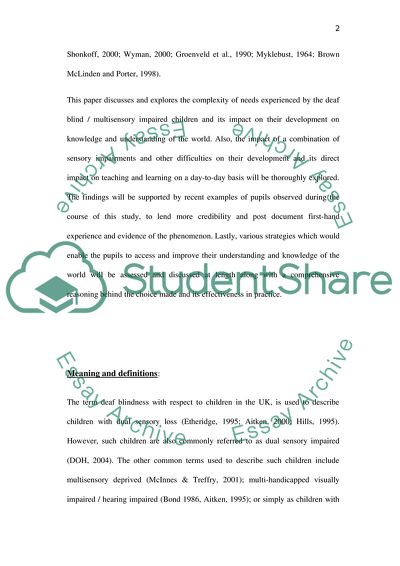Cite this document
(Educational Assessment of Deafblind Learners Report Example | Topics and Well Written Essays - 3500 words, n.d.)
Educational Assessment of Deafblind Learners Report Example | Topics and Well Written Essays - 3500 words. https://studentshare.org/education/1764173-a-deaf-blind-child-is-not-a-deaf-child-who-cannot-see-or-a-blind-child-who-cannot-hear-the-problem-is-not-an-additive-one-of-deafness-plus-blindness-nor-is-it-solely-one-of-communication-or-perception-it-encompasses-all-these-things-and-more-the-de
Educational Assessment of Deafblind Learners Report Example | Topics and Well Written Essays - 3500 words. https://studentshare.org/education/1764173-a-deaf-blind-child-is-not-a-deaf-child-who-cannot-see-or-a-blind-child-who-cannot-hear-the-problem-is-not-an-additive-one-of-deafness-plus-blindness-nor-is-it-solely-one-of-communication-or-perception-it-encompasses-all-these-things-and-more-the-de
(Educational Assessment of Deafblind Learners Report Example | Topics and Well Written Essays - 3500 Words)
Educational Assessment of Deafblind Learners Report Example | Topics and Well Written Essays - 3500 Words. https://studentshare.org/education/1764173-a-deaf-blind-child-is-not-a-deaf-child-who-cannot-see-or-a-blind-child-who-cannot-hear-the-problem-is-not-an-additive-one-of-deafness-plus-blindness-nor-is-it-solely-one-of-communication-or-perception-it-encompasses-all-these-things-and-more-the-de.
Educational Assessment of Deafblind Learners Report Example | Topics and Well Written Essays - 3500 Words. https://studentshare.org/education/1764173-a-deaf-blind-child-is-not-a-deaf-child-who-cannot-see-or-a-blind-child-who-cannot-hear-the-problem-is-not-an-additive-one-of-deafness-plus-blindness-nor-is-it-solely-one-of-communication-or-perception-it-encompasses-all-these-things-and-more-the-de.
“Educational Assessment of Deafblind Learners Report Example | Topics and Well Written Essays - 3500 Words”. https://studentshare.org/education/1764173-a-deaf-blind-child-is-not-a-deaf-child-who-cannot-see-or-a-blind-child-who-cannot-hear-the-problem-is-not-an-additive-one-of-deafness-plus-blindness-nor-is-it-solely-one-of-communication-or-perception-it-encompasses-all-these-things-and-more-the-de.


